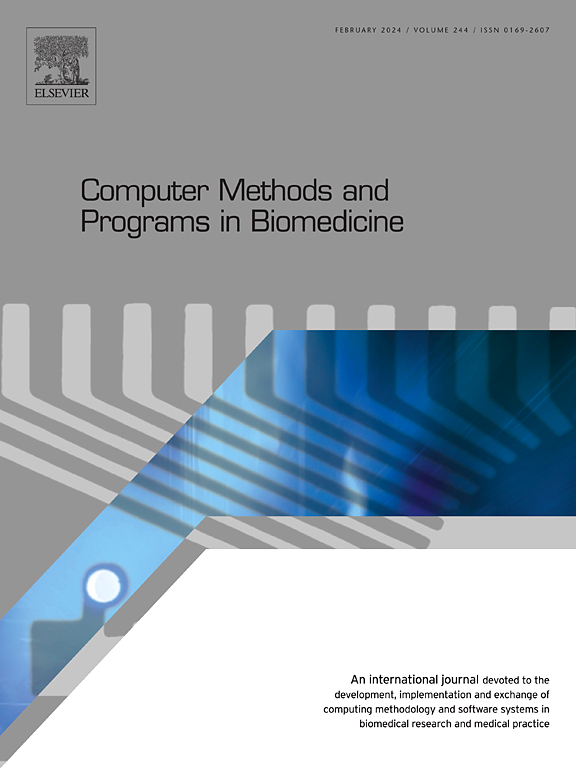虚拟心脏组织学:在健康和病理条件下左心室心肌的放射密度测定特征
IF 4.9
2区 医学
Q1 COMPUTER SCIENCE, INTERDISCIPLINARY APPLICATIONS
引用次数: 0
摘要
背景与目的:心血管影像学对疾病的认识和病情的严重程度起着至关重要的作用。尽管由于空间分辨率的提高,形态学评估取得了良好的结果,但心脏组织状态的功能评估仍然缺乏。这项工作的目的是执行一个虚拟心脏组织学,意思是用计算机断层扫描图像来表征左心室的心脏组织,并使用密度分布来检测心脏疾病的存在,如急性心肌梗死和肥厚性心肌病。方法:本研究回顾性分析了60名受试者的体积数据,平均分布在不同的类别中,开发了一种图像处理管道,用于半自动提取不同层次和部分的三维虚拟样本。从每个样本的密度剖面中提取一组统计描述符。结果:密度表征检测到左心室组织的异质性,区分室间隔更导电的肌细胞和其他节段更收缩的肌细胞。此外,发现放射密度梯度从瓣膜面(基底)向心尖移动。由于观察到几何形状的改变和轮廓的移位(振幅= 0.02,肌肉HU = 57),在心肌梗死引起的病理改变中,室间隔也被发现是一个重要的结构。肥厚性心肌病引起收缩节段强度(肌肉5-7 HU增加)和轮廓形状(振幅= 0.21下壁)的显著变化,报告这些节段缺乏生理性脂肪和结缔组织(脂肪体积= 0.2%)。结论:本研究引入了一种新的方法,利用CT密度测量特性来表征左心室心肌,并区分健康组织和病理组织。与肥厚性心肌病和急性心肌梗死相关的显著模式突出了这种方法对心脏风险分层的潜力。本文章由计算机程序翻译,如有差异,请以英文原文为准。
Virtual cardiac histology: Towards a radiodensitometric characterization of left ventricular cardiac muscle in healthy and pathological conditions
Background and Objective:
Cardiovascular imaging plays a crucial role in disease understanding and case severity. Despite good results in morphological assessment due to an elevated spatial resolution, functional evaluation about cardiac tissue status is still lacking. The aim of the work was to perform a virtual cardiac histology, meaning to characterize cardiac tissue of the left ventricle with Computed Tomography images and use densitometric distribution to detect the presence of cardiac diseases such as acute myocardial infarction and hypertrophic cardiomyopathy.
Methods:
The study retrospectively analyzed volumetric data from sixty subjects, equally distributed among classes, developing a pipeline of image processing for the semi-automatic extraction of 3D virtual samples from different levels and segments. From each sample’s densitometric profile, a set of statistical descriptor were extracted.
Results:
The densitometric characterization detected heterogeneity in the left ventricular tissue, differentiating the more conductive myocytes of the septum with the more contractive myocytes of the other segments. In addition, a gradient of radiodensity was found as moving from the valvular plane (basal) to the apex of the heart. The intraventricular septum was also found as an eloquent structure in pathological changes due to myocardial infarction since a geometrical modification and shift of the profile was observed (Amplitude = 0.02, Muscle HU = 57). The hypertrophic cardiomyopathy caused significative changes in the contractile segments intensity (Muscle 5-7 HU increase) and shape of the profile (Amplitude = 0.21 inferior wall) reporting the absence of physiological fat and connective tissue in those segments (fat volume = 0.2 %).
Conclusion:
This study introduces a novel methodology leveraging CT densitometric properties to characterize left ventricular myocardium and distinguish healthy from pathological tissue. Significant patterns associated with hypertrophic cardiomyopathy and acute myocardial infarction highlight the potential of this approach for cardiac risk stratification.
求助全文
通过发布文献求助,成功后即可免费获取论文全文。
去求助
来源期刊

Computer methods and programs in biomedicine
工程技术-工程:生物医学
CiteScore
12.30
自引率
6.60%
发文量
601
审稿时长
135 days
期刊介绍:
To encourage the development of formal computing methods, and their application in biomedical research and medical practice, by illustration of fundamental principles in biomedical informatics research; to stimulate basic research into application software design; to report the state of research of biomedical information processing projects; to report new computer methodologies applied in biomedical areas; the eventual distribution of demonstrable software to avoid duplication of effort; to provide a forum for discussion and improvement of existing software; to optimize contact between national organizations and regional user groups by promoting an international exchange of information on formal methods, standards and software in biomedicine.
Computer Methods and Programs in Biomedicine covers computing methodology and software systems derived from computing science for implementation in all aspects of biomedical research and medical practice. It is designed to serve: biochemists; biologists; geneticists; immunologists; neuroscientists; pharmacologists; toxicologists; clinicians; epidemiologists; psychiatrists; psychologists; cardiologists; chemists; (radio)physicists; computer scientists; programmers and systems analysts; biomedical, clinical, electrical and other engineers; teachers of medical informatics and users of educational software.
 求助内容:
求助内容: 应助结果提醒方式:
应助结果提醒方式:


